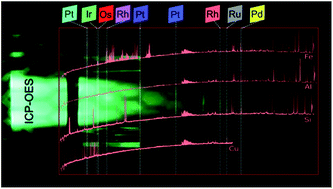当前位置:
X-MOL 学术
›
J. Anal. At. Spectrom.
›
论文详情
Our official English website, www.x-mol.net, welcomes your
feedback! (Note: you will need to create a separate account there.)
Matrix complexity effect on platinum group metals analysis using inductively coupled plasma optical emission spectrometry†
Journal of Analytical Atomic Spectrometry ( IF 3.1 ) Pub Date : 2018-07-09 00:00:00 , DOI: 10.1039/c8ja00158h Jihye Kim 1, 2, 3, 4, 5 , John Anawati 1, 2, 3, 4, 5 , Gisele Azimi 1, 2, 3, 4, 5
Journal of Analytical Atomic Spectrometry ( IF 3.1 ) Pub Date : 2018-07-09 00:00:00 , DOI: 10.1039/c8ja00158h Jihye Kim 1, 2, 3, 4, 5 , John Anawati 1, 2, 3, 4, 5 , Gisele Azimi 1, 2, 3, 4, 5
Affiliation

|
Recent global actions to mitigate climate change have sparked the development of critical green technologies that rely on strategic materials with unique properties. Examples include Platinum Group Metals (PGMs) that are in increasingly high demand in the manufacturing of green catalysts, but facing supply uncertainty. For tackling the sustainability challenges associated with PGMs supply, activities have been initiated to mine these elements from low-grade ores and postconsumer automotive catalytic converters. However, such sources are highly concentrated with other elements, such as iron, aluminum, and silicon, causing analytical interferences during PGM quantitative analyses, making the measurements unreliable. Here, we performed a systematic investigation to determine the effect of matrix complexity in terms of analyte concentration, number of interferents, concentration of interferents, and identity of interferents on the measurement performance of nine emission lines of PGMs, when inductively coupled plasma optical emission spectrometry (ICP-OES) is utilized. Results indicate that depending on the combination of parameters, the concentration of all PGMs, except for osmium, is underestimated when the matrix contains Fe, Ca, Mn, Cr, Mg, Al, Si, Pb, and Cu. This observation is attributed to spectral interferences and inter-element effects, caused by ionization and chemical interferences. The distinctive behavior of osmium is attributed to the memory effect because of its high volatility and stickiness in the nitrate media. Statistical analyses were utilized to evaluate the coefficient of determination, error distribution, and precision of the instrument to establish a set of guidelines for selecting PGMs emission lines, depending on the matrix complexity. To highlight the practical implication of this study, NIST 2557 auto-catalyst standard was analyzed as a reference material, indicating the applicability of the developed guidelines. We expect our findings will help address some critical aspects of selecting suitable emission lines during PGMs quantifications in complex matrices, such as ores and automotive catalytic converters.
中文翻译:

矩阵复杂度对电感耦合等离子体发射光谱法分析铂族金属的影响†
最近在全球范围内采取的缓解气候变化的行动已激发了关键绿色技术的发展,这些技术依赖于具有独特特性的战略材料。例如,铂族金属(PGM)在制造绿色催化剂方面有越来越高的需求,但面临供应不确定性。为了应对与铂族金属供应相关的可持续性挑战,已经开始开展活动,从低品位矿石和消费后的汽车催化转化器中开采这些元素。但是,此类源高度集中于其他元素,例如铁,铝和硅,在PGM定量分析过程中会引起分析干扰,从而使测量不可靠。在这里,我们进行了系统的调查,以确定分析物浓度对基质复杂性的影响,当使用电感耦合等离子体发射光谱法(ICP-OES)时,PGM的9条发射线的测量性能上的干扰物数量,干扰物浓度以及干扰物的身份。结果表明,根据参数的组合,当基质中含有Fe,Ca,Mn,Cr,Mg,Al,Si,Pb和Cu时,除以外的所有PGM的浓度都被低估了。该观察结果归因于由电离和化学干扰引起的光谱干扰和元素间效应。nitrate的独特行为归因于记忆效应,因为它在硝酸盐介质中具有很高的挥发性和粘性。统计分析用于评估确定系数,误差分布,仪器的精度和精确度,以根据矩阵的复杂性建立一套选择PGM发射线的指南。为了突出本研究的实际意义,对NIST 2557自动催化剂标准品进行了分析,以作为参考材料,表明所制定准则的适用性。我们希望我们的发现将有助于解决在复杂基质(例如矿石和汽车催化转化器)中进行PGM定量时选择合适的排放管线的一些关键方面。
更新日期:2018-07-09
中文翻译:

矩阵复杂度对电感耦合等离子体发射光谱法分析铂族金属的影响†
最近在全球范围内采取的缓解气候变化的行动已激发了关键绿色技术的发展,这些技术依赖于具有独特特性的战略材料。例如,铂族金属(PGM)在制造绿色催化剂方面有越来越高的需求,但面临供应不确定性。为了应对与铂族金属供应相关的可持续性挑战,已经开始开展活动,从低品位矿石和消费后的汽车催化转化器中开采这些元素。但是,此类源高度集中于其他元素,例如铁,铝和硅,在PGM定量分析过程中会引起分析干扰,从而使测量不可靠。在这里,我们进行了系统的调查,以确定分析物浓度对基质复杂性的影响,当使用电感耦合等离子体发射光谱法(ICP-OES)时,PGM的9条发射线的测量性能上的干扰物数量,干扰物浓度以及干扰物的身份。结果表明,根据参数的组合,当基质中含有Fe,Ca,Mn,Cr,Mg,Al,Si,Pb和Cu时,除以外的所有PGM的浓度都被低估了。该观察结果归因于由电离和化学干扰引起的光谱干扰和元素间效应。nitrate的独特行为归因于记忆效应,因为它在硝酸盐介质中具有很高的挥发性和粘性。统计分析用于评估确定系数,误差分布,仪器的精度和精确度,以根据矩阵的复杂性建立一套选择PGM发射线的指南。为了突出本研究的实际意义,对NIST 2557自动催化剂标准品进行了分析,以作为参考材料,表明所制定准则的适用性。我们希望我们的发现将有助于解决在复杂基质(例如矿石和汽车催化转化器)中进行PGM定量时选择合适的排放管线的一些关键方面。











































 京公网安备 11010802027423号
京公网安备 11010802027423号